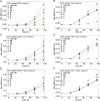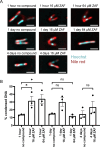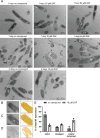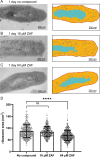Zafirlukast induces DNA condensation and has bactericidal effect on replicating Mycobacterium abscessus
- PMID: 38990015
- PMCID: PMC11304721
- DOI: 10.1128/aac.00029-24
Zafirlukast induces DNA condensation and has bactericidal effect on replicating Mycobacterium abscessus
Abstract
Mycobacterium abscessus infections are emerging in cystic fibrosis patients, and treatment success rate in these patients is only 33% due to extreme antibiotic resistance. Thus, new treatment options are essential. An interesting target could be Lsr2, a nucleoid-associated protein involved in mycobacterial virulence. Zafirlukast is a Food and Drug Administration (FDA)-approved drug against asthma that was shown to bind Lsr2. In this study, zafirlukast treatment is shown to reduce M. abscessus growth, with a minimal inhibitory concentration of 16 µM and a bactericidal concentration of 64 µM in replicating bacteria only. As an initial response, DNA condensation, a known stress response of mycobacteria, occurs after 1 h of treatment with zafirlukast. During continued zafirlukast treatment, the morphology of the bacteria alters and the structural integrity of the bacteria is lost. After 4 days of treatment, reduced viability is measured in different culture media, and growth of M. abscessus is reduced in a dose-dependent manner. Using transmission electron microscopy, we demonstrated that the hydrophobic multilayered cell wall and periplasm are disorganized and ribosomes are reduced in size and relocalized. In summary, our data demonstrate that zafirlukast alters the morphology of M. abscessus and is bactericidal at 64 µM. The bactericidal concentration of zafirlukast is relatively high, and it is only effective on replicating bacteria but as zafirlukast is an FDA-approved drug, and currently used as an anti-asthma treatment, it could be an interesting drug to further study in in vivo experiments to determine whether it could be used as an antibiotic for M. abscessus infections.
Keywords: Mycobacterium abscessus; antibiotics; electron microscopy; zafirlukast.
Conflict of interest statement
The authors declare no conflict of interest.
Figures






Similar articles
-
Zafirlukast inhibits complexation of Lsr2 with DNA and growth of Mycobacterium tuberculosis.Antimicrob Agents Chemother. 2013 May;57(5):2134-40. doi: 10.1128/AAC.02407-12. Epub 2013 Feb 25. Antimicrob Agents Chemother. 2013. PMID: 23439641 Free PMC article.
-
Lsr2, a pleiotropic regulator at the core of the infectious strategy of Mycobacterium abscessus.Microbiol Spectr. 2024 Mar 5;12(3):e0352823. doi: 10.1128/spectrum.03528-23. Epub 2024 Feb 14. Microbiol Spectr. 2024. PMID: 38353553 Free PMC article.
-
Altered serine metabolism promotes drug tolerance in Mycobacterium abscessus via a WhiB7-mediated adaptive stress response.Antimicrob Agents Chemother. 2024 Jun 5;68(6):e0145623. doi: 10.1128/aac.01456-23. Epub 2024 Apr 23. Antimicrob Agents Chemother. 2024. PMID: 38651855 Free PMC article.
-
Interaction of South Asian spices with conventional antibiotics: Implications for antimicrobial resistance for Mycobacterium abscessus and cystic fibrosis.Int J Mycobacteriol. 2018 Jul-Sep;7(3):257-260. doi: 10.4103/ijmy.ijmy_72_18. Int J Mycobacteriol. 2018. PMID: 30198506
-
Non-tuberculous mycobacteria and the rise of Mycobacterium abscessus.Nat Rev Microbiol. 2020 Jul;18(7):392-407. doi: 10.1038/s41579-020-0331-1. Epub 2020 Feb 21. Nat Rev Microbiol. 2020. PMID: 32086501 Review.
References
-
- Kwak N, Dalcolmo MP, Daley CL, Eather G, Gayoso R, Hasegawa N, Jhun BW, Koh W-J, Namkoong H, Park J, Thomson R, van Ingen J, Zweijpfenning SMH, Yim J-J. 2019. Mycobacterium abscessus pulmonary disease: individual patient data meta-analysis. Eur Respir J 54:1801991. doi:10.1183/13993003.01991-2018 - DOI - PubMed
-
- Bryant JM, Grogono DM, Rodriguez-Rincon D, Everall I, Brown KP, Moreno P, Verma D, Hill E, Drijkoningen J, Gilligan P, et al. . 2016. Population-level genomics identifies the emergence and global spread of a human transmissible multidrug-resistant nontuberculous mycobacterium. Science 354:751–757. doi:10.1126/science.aaf8156 - DOI - PMC - PubMed
Publication types
MeSH terms
Substances
Grants and funding
LinkOut - more resources
Full Text Sources
Medical
Molecular Biology Databases
Research Materials

